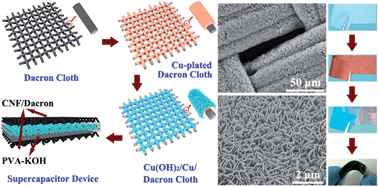Commercial Dacron cloth supported Cu(OH)2 nanobelt arrays for wearable supercapacitors†
Abstract
Wearable supercapacitors have attracted considerable research interest in recent years. However, most of the wearable supercapacitors reported are either in the form of fibers or based on carbon cloth which have to be knitted into commercial cloth for wearable applications. Here we report the growth of Cu(OH)2 nanobelt arrays directly on commercial Dacron cloth which serves as a positive electrode for supercapacitors. The as-prepared electrode has a high specific capacitance of 217 mF·cm−2 at a current density of 0.5 mA·cm−2 with a capacitance retention of 90% at a current density of 2 mA·cm−2 after 3000 charge/discharge cycles. A flexible all-solid-state asymmetrical supercapacitor is fabricated by sandwiching the Dacron cloth supported Cu(OH)2 nanobelt arrays (positive electrode) between two carbon nanofiber matrices (negative electrodes), using KOH-PVA gel as the electrolyte and as the separator. A high areal capacitance of 195.8 mF·cm−2 at a current density of 1 mA·cm−2 can be achieved. The textile supercapacitor exhibits an energy density of 3.6 × 10−2 mWh·cm−2 at a power density of 0.6 mW·cm−2 with a voltage window of 1.2 V. This sandwich type of supercapacitor based on commercial Dacron cloth opens a novel way of integrating supercapacitors into textiles, showing great promise for wearable electronic applications.


 Please wait while we load your content...
Please wait while we load your content...